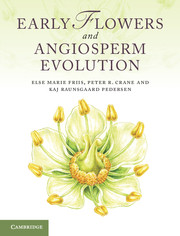Book contents
- Frontmatter
- Contents
- Preface
- 1 Introduction to angiosperms
- 2 The nature of the angiosperm fossil record
- 3 The environmental context of early angiosperm evolution
- 4 Stratigraphic framework and key areas for Cretaceous angiosperms
- 5 Angiosperms in context: extant and fossil seed plants
- 6 Origin and age of angiosperms
- 7 Phylogenetic framework and the assignment of fossils to extant groups
- 8 Fossils near the base of the angiosperm tree
- 9 Early fossil angiosperms of uncertain relationships
- 10 Early fossils of eumagnoliids
- 11 Fossils of monocots
- 12 Fossils of eudicots: early-diverging groups
- 13 Fossils of core eudicots: basal lineages
- 14 Fossils of core eudicots: rosids
- 15 Early fossils of eudicots: asterids
- 16 Patterns of structural diversification in angiosperm reproductive organs
- 17 History and evolution of pollination in angiosperms
- 18 History and evolution of dispersal in angiosperms
- 19 Vegetational context of early angiosperm diversification
- 20 The accumulation of angiosperm diversity
- References
- Index
7 - Phylogenetic framework and the assignment of fossils to extant groups
Published online by Cambridge University Press: 07 September 2011
- Frontmatter
- Contents
- Preface
- 1 Introduction to angiosperms
- 2 The nature of the angiosperm fossil record
- 3 The environmental context of early angiosperm evolution
- 4 Stratigraphic framework and key areas for Cretaceous angiosperms
- 5 Angiosperms in context: extant and fossil seed plants
- 6 Origin and age of angiosperms
- 7 Phylogenetic framework and the assignment of fossils to extant groups
- 8 Fossils near the base of the angiosperm tree
- 9 Early fossil angiosperms of uncertain relationships
- 10 Early fossils of eumagnoliids
- 11 Fossils of monocots
- 12 Fossils of eudicots: early-diverging groups
- 13 Fossils of core eudicots: basal lineages
- 14 Fossils of core eudicots: rosids
- 15 Early fossils of eudicots: asterids
- 16 Patterns of structural diversification in angiosperm reproductive organs
- 17 History and evolution of pollination in angiosperms
- 18 History and evolution of dispersal in angiosperms
- 19 Vegetational context of early angiosperm diversification
- 20 The accumulation of angiosperm diversity
- References
- Index
Summary
Over the past two decades there has been rapid progress in developing a phylogenetic framework within which to interpret many aspects of angiosperm evolution. This progress has been brought about mainly through the application of molecular phylogenetics to an increasingly large sample of flowering plants. In this chapter we briefly review the development of ideas on angiosperm phylogeny and outline the current state of knowledge based on the most recent APGIII classification (2009). Phylogenetic patterns within particular groups are summarised in Chapters 8–15. In this chapter we also briefly discuss the issues that need to be considered in assigning fossils to extant groups. This is essential background to what follows in Chapters 8–15.
Early ideas on angiosperm phylogeny
The Euanthial (Anthostrobilus) Theory of the angiosperm flower, which interprets the flower as a uniaxial structure (Chapter 6), is at the core of most phylogenetic interpretations of angiosperm evolution developed in the second half of the twentieth century. In their emphasis on Magnoliaceae and their relatives as a starting point for angiosperm evolution, such phylogenetic schemes trace their origin to the pre-Darwinian classifications of De Candolle and Bentham and Hooker, but they have been broadly supported by comparative data from many sources, especially from wood anatomy (Bailey, 1944; Eames, 1961; Dickison, 1975) and palynology (Woodhouse, 1935; Walker, 1974a, b, 1976). The classifications of Hutchinson (1959), Cronquist (1968, 1981), Takhtajan (1969, 1980), Thorne (1976) and Dahlgren (1980) all represent different manifestations, each with their own idiosyncrasies, of the Euanthial paradigm.
- Type
- Chapter
- Information
- Early Flowers and Angiosperm Evolution , pp. 163 - 168Publisher: Cambridge University PressPrint publication year: 2011



